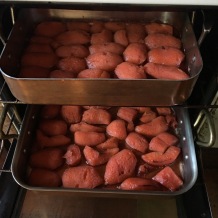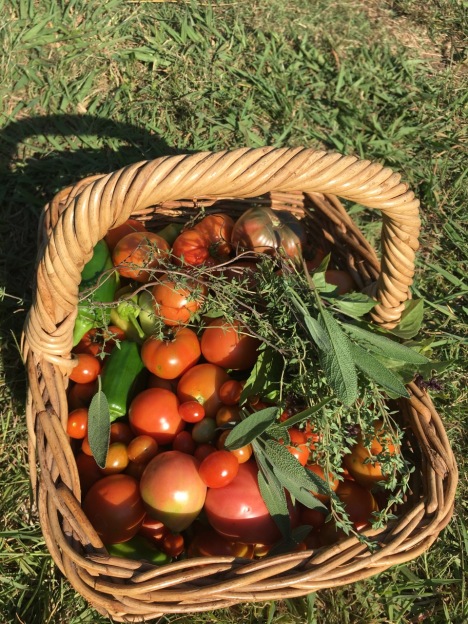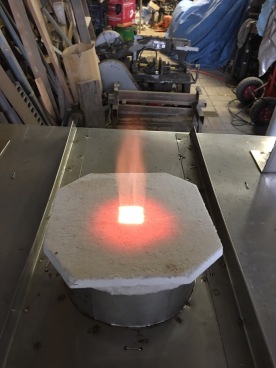Our international guest and pottery/environmental living intern, Ms Kang from Korea, is about to leave us. We spend our time in the pottery, garden and kitchen. We put in a big day from early morning through till late night, a 14 hour day. There is a lot to get done at this time of year.
We have glazed our pots and packed the kiln previously, so while we wait for the sun to get up in the sky so that we can start the firing. I get up on the roof and wash the solar panels. We live on a dirt road which is quite dusty in dry weather. We recently had a good rain storm and collected 75mm. (3″) of rain, but then we had 150mm. (6″) of wind and dust, This means that I need to wash the PV panels so that we achieve maximum efficiency. At this time of year, the shadow from the trees doesn’t pass off the last of the panels until 10.00am.



By 10.00am the sun is up in the sky and we are generating good energy, it’s a good time to switch on the electric kiln. I wait until the PV panels are generating enough power before I start the firing. I like to start about 10-ish and finish by 5-ish, thus making the most of the sun. The kiln is very powerful and can easily fire straight through to Stoneware 1300oC in 5 hours if needed. Once the kiln gets to 1000oC, I start reduction with 2 small pilot burners running at 5 kpa. I can’t set the pressure any lower than this and expect it to be reliable. This takes the kiln through to 1300 in reduction using just 300 grams of gas. I’m still experimenting with this kiln.
If we want to fire longer, or on cloudy days when there isn’t enough direct sunlight, we have the Tesla battery to fill the gap. We can, if needed, fire the kiln and charge the car as well on the same day. On a good sunny day, we can charge both car and Kiln, fill the battery and still sell a little to the grid. On the off days when we don’t fire or drive the car, we sell everything to the grid. We sell our excess at 20 cents per kW/hr. occasionally when it is cloudy for a few days we buy back power from the grid. We chose a 100% green power contract and pay the premium price of 35 cents per kW/hr for the privilege. However, we are connected to the grid by a net meter, so we only have to pay for power if our imports exceeds our exports in any given month. It never does.
Once the kiln is on, It fires itself in semi-automatic mode. I only need to check it occasionally. Then its back into the garden to continue the harvest of more tomatoes, chilis, capsicums and aubergines. We are at peak tomatoes now, as we dealt with the last of the late-season plums last week. They are all safely vacuumed sealed in their jars, in the pantry, waiting for later in the year.



While I harvest the tomatoes et al, in the vegetable garden, the ladies, Ms’s King & Kang collect hazel nuts and quinces from the orchard. We are all soon very busy in the kitchen, by the time the heat of the day sets in. All the tomatoes need to be washed and sorted. Even though we have set fruit fly traps all around our garden and orchards, we still get some fruit fly stings in the very ripe tomatoes in this late summer season of hot and damp weather. All the tomatoes are cut open, checked for fly strike and then sorted into two separate pans. A big boiler for the good fruit and a small sauce pan for the fly struck fruit. The spoilt tomatoes are all boiled to kill the grubs and then fed to the chickens, with the remaining skins and detritus composted or fed to the worms.


While I’m cooking, Ms Kang is shelling the days pick of hazelnuts. This batch of tomato passata will be cooked with pepper corns, bay leaves and a bottle of good red wine. It looks great and tastes delightfully sweet and sharp, sort of tangy, with just a little bite and lingering heat from a few chilli peppers in the mix.
The quinces are washed, peeled sliced and then boiled with a little sugar, 300g in the big boiler + a couple of litres of water to cover them. I add a stick of cinnamon, a few cloves and two star anise. After they have softened. I transfer them to baking trays, pouring the sweet boiling liqueur over them and add a little bit of Canadian maple syrup into the mix I give them 45 mins at 180 and this reduces the liquer to a sticky gel and turns the fruit to a lovely red colour. I choose to cook them with a minimum of sugar. If I added more sugar, they would turn a deeper/richer shade of claret red. I love that colour, but don’t like the saturated sweetness.


We preserve everything in our antique ‘Fowlers’ Preserving jars. We bought this old boiler and a few boxes of glass jars, 2nd hand at a garage sale over 40 years ago and they are still giving good service. We have only had to replace the rubber rings.



It still surprises me that a basket full of quince fruit can fill the sink when being washed, then fill 2 baking dishes in the cooking and finally be reduced to just 3 jars of concentrated sunlight, colour and flavour after a days work. Two baskets of tomatoes fills two boilers, then makes only 4 jars of passata once it has been reduced on the stove for an few hour.
Such is the business of summer.










































You must be logged in to post a comment.